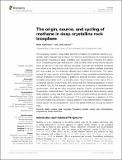Files in this item
The origin, source, and cycling of methane in deep crystalline rock biosphere
Item metadata
| dc.contributor.author | Kietäväinen, Riikka | |
| dc.contributor.author | Purkamo, Lotta | |
| dc.date.accessioned | 2017-02-03T15:30:11Z | |
| dc.date.available | 2017-02-03T15:30:11Z | |
| dc.date.issued | 2015-07-17 | |
| dc.identifier | 249070202 | |
| dc.identifier | 56c97862-9f40-4021-9666-289c2421a3cf | |
| dc.identifier | 26236303 | |
| dc.identifier | 84938944914 | |
| dc.identifier.citation | Kietäväinen , R & Purkamo , L 2015 , ' The origin, source, and cycling of methane in deep crystalline rock biosphere ' , Frontiers in Microbiology , vol. 6 , 725 , pp. 1-16 . https://doi.org/10.3389/fmicb.2015.00725 | en |
| dc.identifier.issn | 1664-302X | |
| dc.identifier.other | PubMedCentral: PMC4505394 | |
| dc.identifier.uri | https://hdl.handle.net/10023/10225 | |
| dc.description | RK would like to thank the Finnish Research Program on Nuclear Waste Management (grants SALAMI and RENGAS) for funding. | en |
| dc.description.abstract | The emerging interest in using stable bedrock formations for industrial purposes, e.g., nuclear waste disposal, has increased the need for understanding microbiological and geochemical processes in deep crystalline rock environments, including the carbon cycle. Considering the origin and evolution of life on Earth, these environments may also serve as windows to the past. Various geological, chemical, and biological processes can influence the deep carbon cycle. Conditions of CH4 formation, available substrates and time scales can be drastically different from surface environments. This paper reviews the origin, source, and cycling of methane in deep terrestrial crystalline bedrock with an emphasis on microbiology. In addition to potential formation pathways of CH4, microbial consumption of CH4 is also discussed. Recent studies on the origin of CH4 in continental bedrock environments have shown that the traditional separation of biotic and abiotic CH4 by the isotopic composition can be misleading in substrate-limited environments, such as the deep crystalline bedrock. Despite of similarities between Precambrian continental sites in Fennoscandia, South Africa and North America, where deep methane cycling has been studied, common physicochemical properties which could explain the variation in the amount of CH4 and presence or absence of CH4 cycling microbes were not found. However, based on their preferred carbon metabolism, methanogenic microbes appeared to have similar spatial distribution among the different sites. | |
| dc.format.extent | 16 | |
| dc.format.extent | 1069165 | |
| dc.language.iso | eng | |
| dc.relation.ispartof | Frontiers in Microbiology | en |
| dc.subject | Abiotic methane | en |
| dc.subject | Deep subsurface | en |
| dc.subject | Precambrian bedrock | en |
| dc.subject | Carbon cycle | en |
| dc.subject | Methanogenesis | en |
| dc.subject | Methanotrophy | en |
| dc.subject | Isotopic fractionation | en |
| dc.subject | GE Environmental Sciences | en |
| dc.subject.lcc | GE | en |
| dc.title | The origin, source, and cycling of methane in deep crystalline rock biosphere | en |
| dc.type | Journal item | en |
| dc.contributor.institution | University of St Andrews. Earth and Environmental Sciences | en |
| dc.contributor.institution | University of St Andrews. St Andrews Centre for Exoplanet Science | en |
| dc.identifier.doi | 10.3389/fmicb.2015.00725 | |
| dc.description.status | Peer reviewed | en |
This item appears in the following Collection(s)
Items in the St Andrews Research Repository are protected by copyright, with all rights reserved, unless otherwise indicated.

